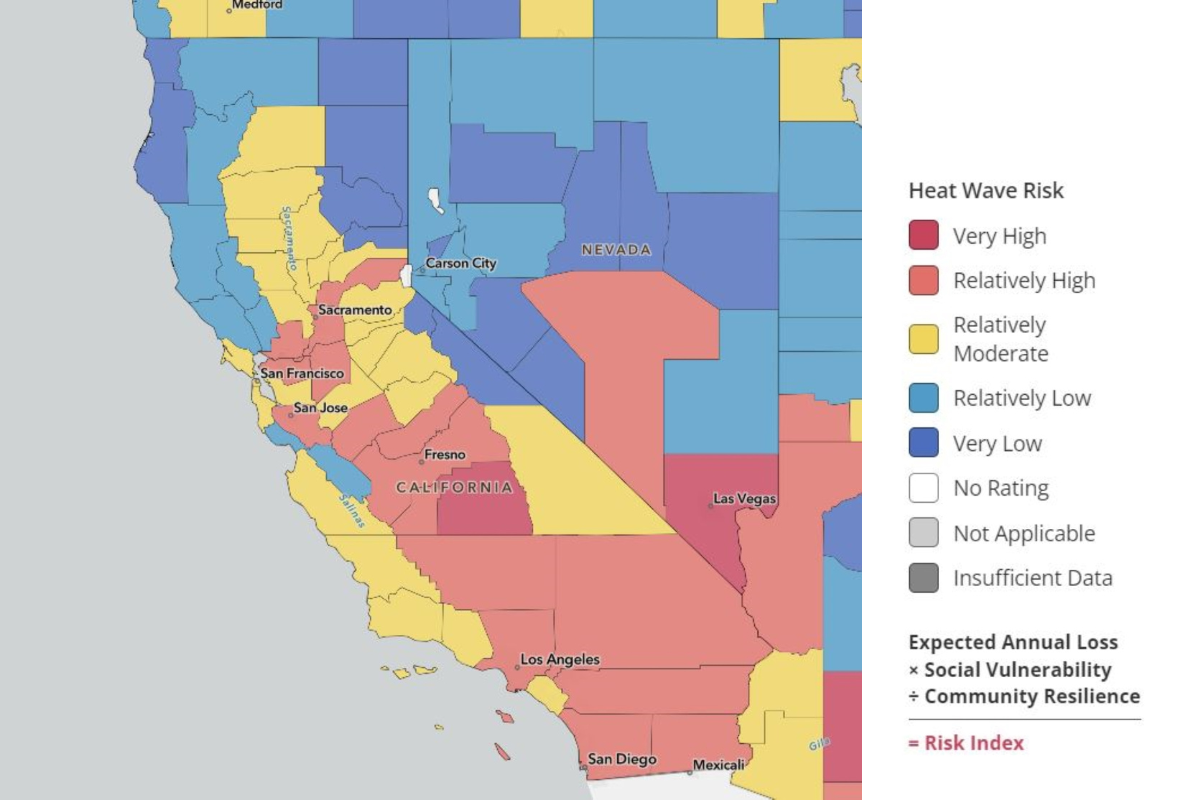With ever-increasing global temperature comes increasing risk from extreme heat events. Extreme heat events and droughts just from 1980 are estimated to have cost the US government 6.4 billion dollars[1]. In addition to environmental and economic damage, extreme heat events exacerbate social inequities. According to the Climate Reality project[2] one study found that low-income neighborhoods are about 13F hotter than wealthier neighborhoods because of the dense development and lack of green space and vegetation. Moreover, the higher cooling costs impacts low-income families the hardest.
According to some statistics, extreme heat events account for an estimated 1,300 deaths per year in the United States[3]. Extreme heat is said to disproportionately impact people over the age of 65, children, people with underlying medical conditions such as cardiovascular and respiratory illnesses, and the economically disadvantaged.
In recent years extreme heat events have caused PG&E outages in summer due to record-breaking energy demands, resulting in further economic loss and social inequities. Extreme heat events are also known to aggravate urban heat islands which are responsible for a 13% increase in cooling costs[4]. The accompanying maps sourced from FEMA show the expected annual loss from extreme heat events and the resulting social vulnerability. These maps allow zooming into specific census tracts for details.
 Hazards.fema.gov
Hazards.fema.gov
At the building scale, extreme heat events affect costs, building operations, durability of materials, life of mechanical systems, health and wellbeing of occupants, productivity, and profitability. Most buildings today are designed to simply meet current local building codes, but rarely address future temperature profiles which will significantly impact the operational costs of the building, and can risk occupants’ health and well-being.
Where to Start
You can make a difference in reducing the effects of extreme heat events by adding a few simple steps to your design process.
- Consider heat impact early in your design process. Perform early energy modeling, massing and façade studies and integrate design elements to reduce heat stress.
- Consider data from current and future climate trends in the design. The following link provides the cooling and heating degree days for California locations based on current and future climate trends. Cooling Degree Days and Heating Degree Days (cal-adapt.org). Other resources include Climate Explorer that offers nationwide projections| U.S. Climate Resilience Toolkit.
- Inform your clients how passive design features in your design save on HVAC equipment and operating costs. Provide first cost versus operating cost for different systems.
What You Can Do Right Now
- Design the building to lower the space conditioning loads: As a first step, consider reducing the cooling loads of the building, lowering the space conditioning operating costs and the building’s dependence on active space conditioning systems, and increasing its resilience.
- Early design studies: Early massing studies and façade optimization assumes greater significance in addressing extreme heat events and the warming climate. Building orientation, window to wall ratio (WWR), shading devices, and glazing must be optimized to limit heat exposure and high cooling costs. These not only save on operational energy costs but prepare the building to be more resilient. Current Title 24 prescribe a maximum WWR of 40% for multi-family and non-residential buildings. Many studies show that a WWR of 50% or more even with high efficiency glazing and reasonable shading results in higher cooling loads than limiting the WWR to 40%.
- Envelope design: The building envelope must be designed for air tightness and must include thermal breaks. The following link describes the strategies to achieve an airtight envelope. Consider using cool walls with an initial solar reflectance of at least 0.6 and thermal emittance of 0.75[5]. According to a study carried out by Lawrence Berkely National Laboratory (LBNL) cool walls perform equal to or better than cool roofs in reducing cooling loads7. The following link provides a list of rated cool walls by Cool Roof Rating Council (CRRC) https://coolroofs.org/directory/wall.
- Consider including ceiling fans in the design. Ceiling fans allow the user to raise the thermostat temperature by an average of 4 F or not use any mechanical cooling in temperate climates[6].
- Night ventilation: Consider night ventilation where feasible and applicable. Night ventilation requires minimum opening of windows that can be controlled with actuators to allow for air movement during cooler conditions. The following link provides applicability of night ventilation and design examples. http://www.2030palette.org/night-vent-cooling/.
- Heat pumps: A study by Rocky Mountain Institute[7] shows that heat pumps perform better than 2 Ton or 4 Ton AC units in maintaining safe indoor temperature during extreme heat while consuming less electricity.
- Heat island effect: To reduce heat island effect, allow for more tree canopy and vegetated areas. Trees reduce surface temperature by 35F and summer air temperature by 3 to 9 F in their vicinity[8]. Consider reducing surface parking lots and asphalt cover. Consider using “cool hardscape” of an initial solar reflectance of at least 0.33[9].
Tools and Resources
- Weather Shift- future weather files and location specific climate trends. https://www.weathershift.com/
- Scorched- Extreme Heat and Real Estate by Urban Land Institute https://knowledge.uli.org/en/Reports/Research%20Reports/2019/Scorched
- Cooling Degree Days and Heating Degree Days (cal-adapt.org)
- Updated Climate Explorer now offers projections for the entire United States | U.S. Climate Resilience Toolkit
Citations/References
[1] https://www.americanprogress.org/article/extreme-weather-cost-u-s-taxpayers-99-billion-last-year-getting-worse/
[2] https://tinyurl.com/5n6kcns9
[3] https://tinyurl.com/5sayyvwp
[4] Scorched Extreme Heat and Real Estate by Urban Land Institute
[5] https://www.usgbc.org/credits/SSpc154-v4.1
[6] https://www.energy.gov/energysaver/fans-cooling
[7] https://rmi.org/why-heat-pumps-are-the-answer-to-heat-waves/
[8] Scorched Extreme Heat and Real Estate by Urban Land Institute
[9] https://www.usgbc.org/credits/new-construction-core-and-shell-schools-new-construction-retail-new-construction-data-cent-5
The Author
Jyothsna Giridhar, Intl. Assoc. AIA, LEED AP BD+C, ENV SP, LFA, WELL AP, Fitwel Ambassador is the Senior Sustainability and Resilience Specialist at Jacobs, an engineering services and consulting firm.

 Hazards.fema.gov
Hazards.fema.gov